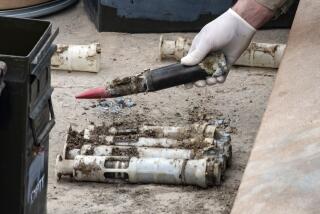Satellite Released Uranium, Scientists Say
- Share via
A nuclear-powered Soviet spy satellite that fell to Earth in 1983 apparently burned up in the upper atmosphere, releasing at least 80% of the 110 pounds of radioactive uranium in its reactor, U.S. scientists said in a report published today.
That radioactivity has dispersed throughout the upper atmosphere, increasing the amount of the most radioactive form of uranium there by 50%, Department of Energy researchers said in the new issue of Science magazine.
Most of the particles will return to the Earth’s surface during the next 20 years, they said.
But because the uranium is so dispersed, it is not a danger to humans or the environment, claimed meteorologist Robert Leifer of DOE’s Environmental Monitoring Laboratory in New York.
But radiochemist Edward Martell of the National Center for Atmospheric Research in Boulder, Colo., said there may be a risk from even the small amounts. “I don’t think you can ignore the carcinogenic potential of uranium,” he said.
The report has raised new concerns among some scientists that nuclear reactors on other Soviet satellites or plutonium heat sources scheduled to be flown on future U.S. space shuttle missions may fall to the Earth or burn up very close to the ground, creating a major radiation hazard.
The Soviet satellite was Cosmos-1402, one of a long series of naval reconnaissance satellites lofted by the Soviet Union to monitor American naval activity.
Each 6,000-pound satellite has a normal operating life of about six months. After six months, small explosive charges break it up into three or more pieces and the nuclear reactor is boosted into a much higher orbit, where it can circle harmlessly for hundreds of years.
But in the case of Cosmos-1402, the booster rockets did not work when the satellite broke apart in December, 1982, causing worldwide concern about falling debris. But on Jan. 23, 1983, the main body of the satellite fell harmlessly into the Indian Ocean.
On Feb. 7, the 1,000-pound reactor section of the satellite disappeared from U.S. radar screens somewhere over the South Atlantic Ocean, about 1,100 miles east of Brazil.
Scientists throughout the world speculated that it had burned up about 46 miles above the Earth’s surface, but no evidence emerged to support this theory.
Leifer and his colleagues had to wait for more than a year for prevailing winds to push some of the dispersed uranium from the satellite into the Northern Hemisphere, where high-altitude sampling by balloon is performed on a routine basis by government agencies. “We just couldn’t afford to go to South America for sampling,” Leifer said in a telephone interview Thursday.
But in February and March of 1984, they did launch balloon flights from Holloman Air Force Base in New Mexico. While the balloon climbed between altitudes of 15 miles and 21 miles, pumps drew air through filters and trapped minute particles containing uranium.
The amount and the isotopic composition of uranium on the filters was then determined by researchers at the National Bureau of Standards in Gaithersburg, Md.
The analysis of the uranium and the calculation of the amounts present in the air took nearly three years, according to Z. Russell Juzdan, Leifer’s co-worker.
From the amounts of uranium present on the filter and from a knowledge of air motions in the upper atmosphere, Leifer and Juzdan calculated that at least 88 pounds of the uranium were dispersed throughout the atmosphere, most of it uranium-235, the highly radioactive isotope that is used in reactors and bombs.
Balloon flights made before Cosmos-1402 fell showed that a significant amount of uranium-235 from above-ground weapons testing was already in the atmosphere, Leifer said. Cosmos-1402 added about 50% more, he said.
Cosmos-1402 is the third satellite carrying radioactive materials that has made an unplanned reentry into the atmosphere. In May, 1964, a U.S. navigational satellite, SNAP-9A, carrying 2.2 pounds of deadly plutonium burned up 24 miles over the Southern Hemisphere after it failed to reach orbit and fell. That plutonium is still detectable today in minute amounts, primarily in the atmosphere over the Southern Hemisphere.
And on Jan. 24, 1978, parts of Cosmos-954, including parts of the reactor, crashed to Earth in a remote region of Canada. Had it crashed in a populated area, according to radiologist Herbert Abrams of Harvard Medical School, it could have presented “an important hazard” to human health. The radioactive debris was cleaned up.
‘Basically Irresponsible’
The continued Soviet use of nuclear reactors in satellites is “basically irresponsible,” said Henry Kendall of the Union of Concerned Scientists, an organization that opposes nuclear weapons and testing. “I am troubled by the whole spirit and philosophy of a program that rains down radioactive debris on our heads.”
The United States does not use nuclear reactors in its satellites, but some future flights of the space shuttle are to carry satellites containing as much as 50 pounds of plutonium.
More to Read
Sign up for Essential California
The most important California stories and recommendations in your inbox every morning.
You may occasionally receive promotional content from the Los Angeles Times.










